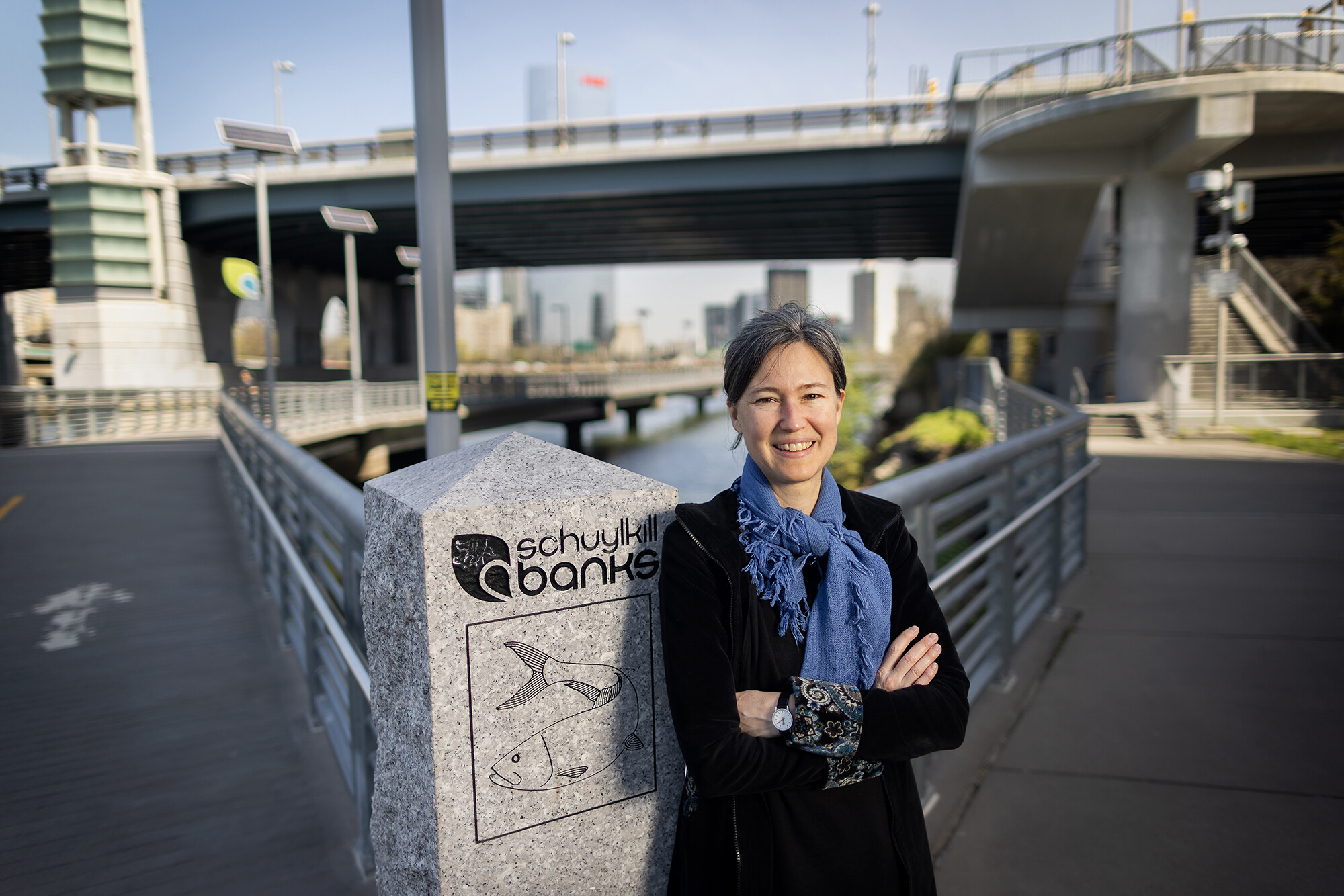
(From left) Doctoral student Hannah Yamagata, research assistant professor Kushol Gupta, and postdoctoral fellow Marshall Padilla holding 3D-printed models of nanoparticles.
(Image: Bella Ciervo)

It’s a surprise sunny afternoon on the Schuylkill River Trail (SRT). People are biking, running, and walking. Travelers lumber down the path with hard-shelled suitcases on their way to 30th Street Station, and schoolgirls scamper up the stairs on their way home from school. A Pomeranian eyes passersby from its perch on a slatted bench while an ersatz fisherman with two poles in the Schuylkill blasts the Beach Boys’ classic lament, “I wish they all could be California girls.”
In other words, the SRT is bustling with activity. People are using the space the way it’s meant to be used, says Sonja Dümpelmann, professor of landscape architecture at the Stuart Weitzman School of Design.
The SRT was built as a way to bring people to the river, restoring the riparian corridor and making it more accessible to pedestrians, Dümpelmann says, in spite of Interstate 76 roaring along on the other bank.
“Any space that facilitates spontaneous use can become entirely different from what the designer perhaps intended. And it becomes an interesting space, becomes the thing that is actually successful,” she says. “It’s such a huge step, I think, for Philly to build this river walk.”
At 3:30 p.m. on a nippy spring day, Dümpelmann is impressed by the volume of people using the space the way designers intended: exercising, strolling, and having loud, one-sided conversations into their headphones. She didn’t realize the path would be so heavily populated. “Daytime, I’m usually in front of a computer,” she says.
In her work, Dümpelmann studies how humans interacted with nonhuman environments throughout history. She’s explored parks and arenas, airports, and street trees. She is writing her next book on grass. In April, she gave a talk in Copenhagen on the racially-charged history of flower boxes in Philadelphia.
“One thing that I’ve been interested in doing here is to draw people’s attention to the many decisions that go into designing things. The fact that this all looks the way it does,” Dümpelmann says, gesturing at the landscape before her, “is the result of conscious decisions, as well as contingencies, and the relationship between the two. There’s a tendency, I think, to take these things for granted.”
A quick look at 20th-century maps shows that some Philadelphia neighborhoods were built with more green space, more street trees, she says. The data now show that those neighborhoods without parks and trees have “less shade and hot summers, and they don’t filter as many particles out of the air, so there are greater asthma risks,” she says.
Dümpelmann wants to draw attention to these decisions. “They have an impact,” she says, “and there’s politics behind these decisions. And it can, in fact, be very discriminatory.”
Primarily, Dümpelmann studies 19th - and 20th-century landscape architecture in the Western Hemisphere. In this tradition, the idea of a garden is often enclosed, she says. “Etymologically, the English word garden is actually derived from the Indo-European term for a fence, gʰerdʰ. That obviously already kind of speaks to exclusion and inclusion and questions of access. These pieces of ground in the past were very often used by regimes and power to quite literally take over.
“Think of the gardens at Versailles,” she says. “That is a very distinct expression of French royal power.” Gardens, she says, have been a very literal tool of colonizing the land.
Landscapes often have rules and regulations. Who has access to landscapes like New York City’s Highline, for instance? Does it close at certain times and certain people don’t have access anymore? A lot of our parks and our big cities are like that after dusk.
“We, as humans, shape the environment and shape the landscape, but then we also experience landscape in a certain way, and that can have an impact on how we then act as humans and interact with each other,” she says. It’s a reciprocal relationship.

Dümpelmann is originally from Germany. There, she pursued a master’s degree as well as a doctorate in landscape architecture because it combined her interests in biology, art history, and graphic design. She eventually found her home in academia and, now, in Philadelphia. “As a historian, it’s incredibly interesting,” Dümpelmann says.
In the mornings, she walks from her Rittenhouse apartment to the University, trying different lanes and alleyways each time. “It’s a neighborly city. The fact that a lot of people have their front doors immediately on the street enables that,” she says.
From her home, Dümpelmann can walk to 30th Street Station. A few weeks ago, she was one of those travelers navigating the SRT on her way to New York. “That’s why the River Trail is super easy,” she says. “I feel very fortunate to live a life where these things are possible.”
Kristina Linnea García

(From left) Doctoral student Hannah Yamagata, research assistant professor Kushol Gupta, and postdoctoral fellow Marshall Padilla holding 3D-printed models of nanoparticles.
(Image: Bella Ciervo)

Jin Liu, Penn’s newest economics faculty member, specializes in international trade.
nocred

nocred

nocred